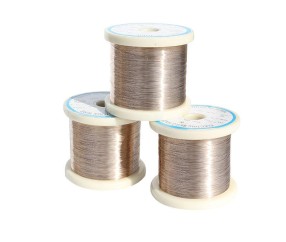The function of Nb element in the material of 0Cr21Al6Nb
Release time:2025-12-24 Strike:745 Inquire Now
Why do they insist on the Nb element in the FeCrAl?

The addition of Niobium (Nb) in the alloy 0Cr21Al6Nb, a ferritic heat-resistant stainless steel with high aluminum content, plays a crucial role in enhancing its properties. Here's an overview of the primary functions of Nb in this material:
1. Precipitation Strengthening
Niobium forms fine, stable precipitates (e.g., NbC or NbN) within the microstructure of the alloy. These precipitates act as obstacles to dislocation motion, which increases the material's strength and hardness.
This mechanism is known as precipitation hardening or dispersion strengthening, and it helps the alloy retain its mechanical strength at elevated temperatures.
2. Improved High-Temperature Creep Resistance
In high-temperature environments, materials can deform under stress over time, a phenomenon known as creep. The addition of Nb enhances the alloy’s resistance to creep by:
Forming stable carbide/nitride precipitates (like NbC or NbN) that reduce grain boundary sliding.
Strengthening the grain boundaries, which are critical sites for creep deformation.
This makes 0Cr21Al6Nb suitable for long-term use in high-temperature applications, such as Heating Element s and industrial furnaces.
3. Oxidation Resistance
Niobium contributes to the formation of a stable and adherent oxide layer when combined with aluminum and chromium in the alloy. This oxide layer (typically Al₂O₃ or Cr₂O₃) provides excellent resistance to oxidation and scaling at high temperatures.
Nb enhances the adhesion of the oxide layer, preventing spallation (flaking off) during thermal cycling.
4. Stabilization of the Microstructure
Niobium helps stabilize the ferritic microstructure by controlling the formation of undesirable phases, such as sigma (σ) phase, which can degrade mechanical and corrosion properties.
Nb prevents grain growth at high temperatures, maintaining fine grain size for better mechanical properties, particularly toughness and ductility.
5. Resistance to High-Temperature Corrosion
In high-temperature environments, particularly where the material may encounter aggressive gases (e.g., sulfur or nitrogen-containing atmospheres), niobium enhances the alloy's resistance to corrosion by forming a protective layer of stable compounds.
This property is particularly valuable for materials like 0Cr21Al6Nb, which are used in heating elements or furnace parts exposed to challenging environments.
6. Suppression of Intergranular Corrosion
Niobium binds with carbon and nitrogen to form stable compounds (e.g., NbC, NbN), reducing the amount of free carbon in the alloy. This prevents the precipitation of chromium carbides (Cr₃C₂) at grain boundaries, which could lead to sensitization and intergranular corrosion.
This effect enhances the corrosion resistance of 0Cr21Al6Nb, particularly in environments where the alloy may experience thermal cycling.
Key Benefits of Nb in 0Cr21Al6Nb
| Property Enhanced | Role of Niobium (Nb) |
|---|---|
| Strength at High Temperatures | Forms stable precipitates (e.g., NbC, NbN) for strengthening. |
| Creep Resistance | Reduces grain boundary sliding through precipitation hardening. |
| Oxidation Resistance | Promotes stable oxide layer formation and adhesion. |
| Corrosion Resistance | Enhances resistance to scaling and aggressive atmospheres. |
| Microstructure Stability | Prevents undesirable phase formation and controls grain growth. |
| Intergranular Corrosion Resistance | Reduces chromium carbide precipitation at grain boundaries. |
Applications of 0Cr21Al6Nb
Heating Elements: The alloy is commonly used in electric heating elements due to its high resistance to oxidation, high-temperature strength, and excellent thermal stability.
Furnace Parts: Components like supports and trays in industrial furnaces.
High-Temperature Components: Used in environments requiring prolonged exposure to elevated temperatures and aggressive atmospheres.
Conclusion
The inclusion of Niobium (Nb) in 0Cr21Al6Nb significantly enhances its high-temperature strength, creep resistance, oxidation resistance, and corrosion resistance. It plays a pivotal role in ensuring the alloy's reliability and longevity in demanding thermal environments, making it ideal for heat-resistant applications.
-
How to Apply for BIS Certificate India
Here is a clear explanation in English on how to apply for a BIS...
-

Alloy28 Stainless steel with 28% Cr and 3% Mo
🔧 UNS N08028 Stainless Steel – Overview and ApplicationsUNS N080...
-

Exploring the Applications of Resistance Wire: From Industrial Heating to Electric Vehicles
Resistance wire is a specialized material widely used in various...
-

How to Caculate the Nichrome80 Temperature
We’re super stoked about our Nichrome 80 wire, a go-to for high-...



